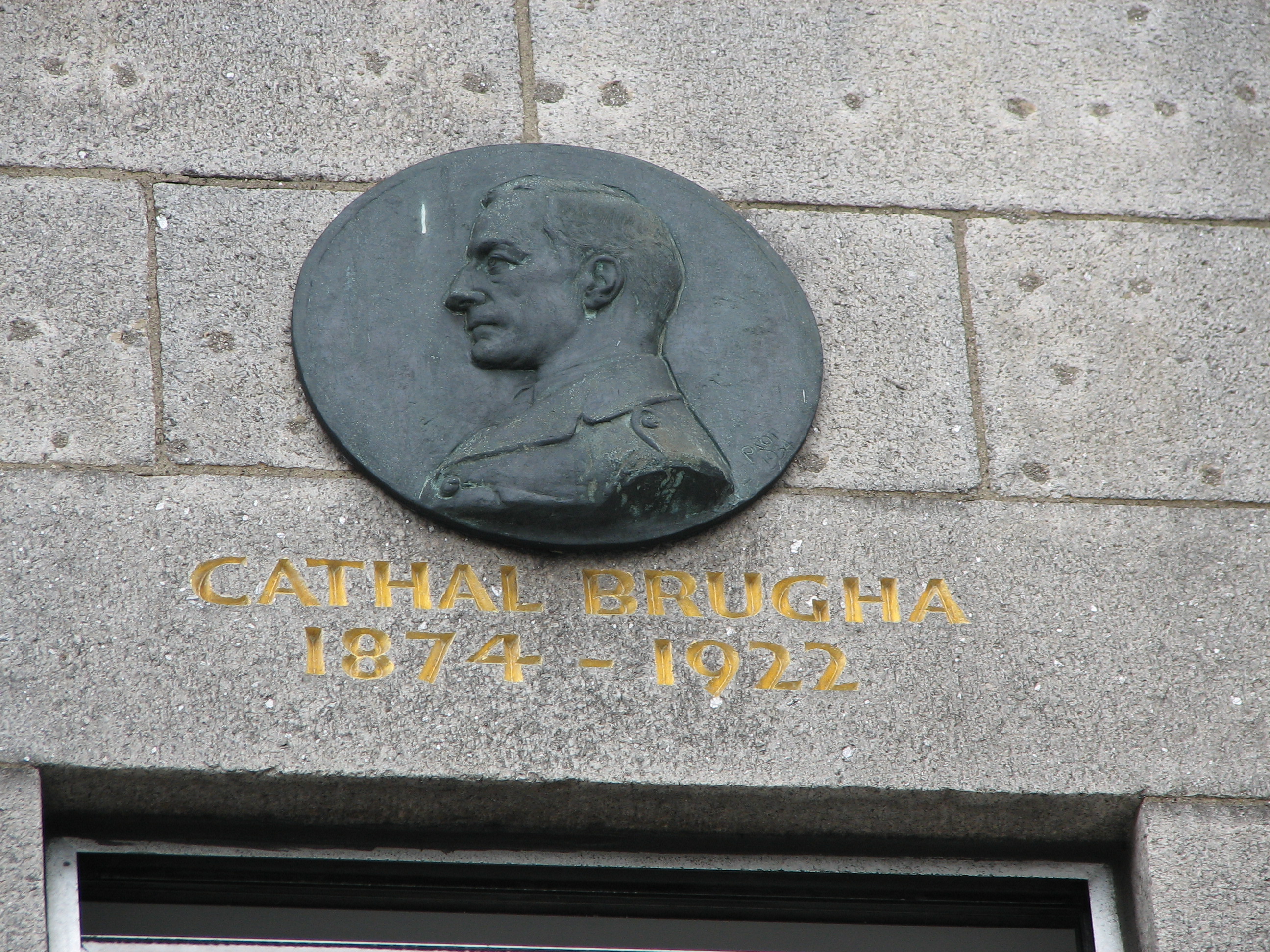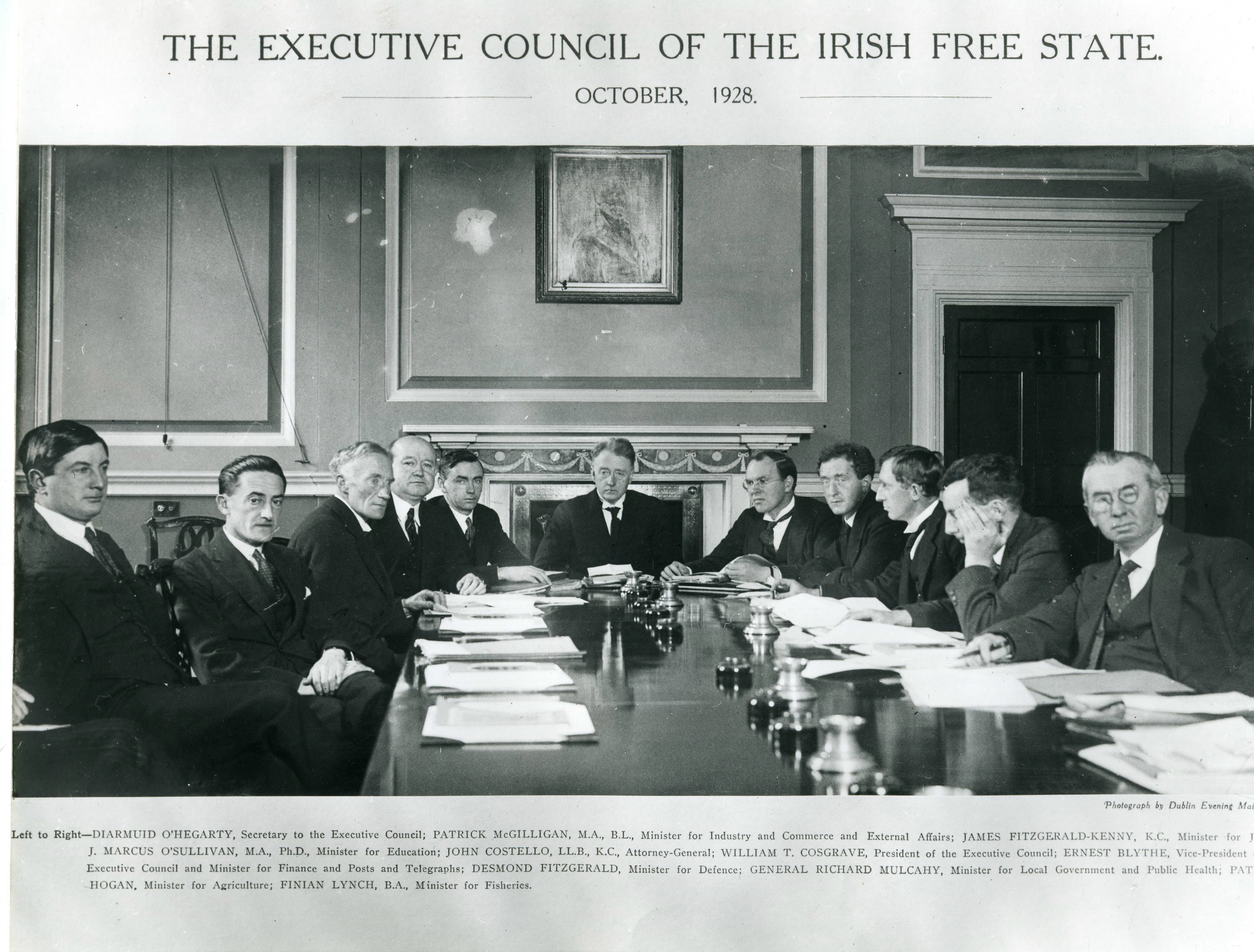|
Minister For Defence (Ireland)
The Minister for Defence () is a senior minister in the Government of Ireland and leads the Department of Defence. The current Minister for Defence is Simon Harris, TD. He is also Minister for Foreign Affairs and Trade. The department is responsible for the Irish Defence Forces. The Ministers and Secretaries Acts 1924 assigned the minister the additional title of Commander-in-Chief as the Chairman of the Council of Defence. The Defence Act 1954 removed this title, as a result of the reconstitution of the Council of Defence. The President of Ireland, a largely ceremonial role, is considered the Supreme Commander of the Defence Forces. In practice, the Minister acts on the President's behalf and reports to the Irish Government. The Minister for Defence is advised by the Council of Defence on the business of the Department of Defence. The Minister is assisted by a Minister of State at the Department of Defence, Thomas Byrne, TD. Ministers for Defence since 1919 ;Notes ... [...More Info...] [...Related Items...] OR: [Wikipedia] [Google] [Baidu] |
Simon Harris
Simon Harris (born 17 October 1986) is an Irish Fine Gael politician serving as Tánaiste, Minister for Foreign Affairs and Trade and Minister for Defence since January 2025, having previously served as Taoiseach from 2024 to 2025. He has been leader of Fine Gael since 2024 and a TD for the Wicklow constituency since 2011. A Cabinet minister since 2016, he previously served as a minister of state from 2014 to 2016. Born in Greystones, Harris became politically active as a teenager, campaigning on behalf of children with autism and attention deficit disorder. He was elected to Wicklow County Council in the 2009 local elections. He was elected to Dáil Éireann at the 2011 general election, becoming the " baby of the Dáil" at age 24, and was appointed Minister of State at the Department of Finance in 2014. Following the formation of a Fine Gael minority government in 2016, he was appointed Minister for Health. On the formation of the coalition government in 20 ... [...More Info...] [...Related Items...] OR: [Wikipedia] [Google] [Baidu] |
President Of The Executive Council Of The Irish Free State
The president of the Executive Council of the Irish Free State () was the head of government or prime minister of the Irish Free State which existed from 1922 to 1937. He was the chairman of the Executive Council of the Irish Free State, the Free State's cabinet (government), cabinet. The president was appointed by the Governor-General of the Irish Free State, governor-general, upon the nomination of Dáil Éireann (Irish Free State), Dáil Éireann (the lower house of parliament) and had to enjoy the confidence of the Dáil to remain in office. The office was succeeded by that of taoiseach, though subsequent Taoisigh are numbered from the first president of the Executive. Appointment The president of the Executive Council was nominated by the Dáil and then formally appointed by the governor-general, though the governor-general was bound by constitutional convention (political custom), constitutional convention to honour the Dáil's choice. On paper, executive (government), exe ... [...More Info...] [...Related Items...] OR: [Wikipedia] [Google] [Baidu] |
1st Executive Council Of The Irish Free State
First most commonly refers to: * First, the ordinal form of the number 1 First or 1st may also refer to: Acronyms * Faint Images of the Radio Sky at Twenty-Centimeters, an astronomical survey carried out by the Very Large Array * Far Infrared and Sub-millimetre Telescope, of the Herschel Space Observatory * For Inspiration and Recognition of Science and Technology, an international youth organization * Forum of Incident Response and Security Teams, a global forum Arts and entertainment Albums * ''1st'' (album), by Streets, 1983 * ''1ST'' (SixTones album), 2021 * ''First'' (David Gates album), 1973 * ''First'', by Denise Ho, 2001 * ''First'' (O'Bryan album), 2007 * ''First'' (Raymond Lam album), 2011 Extended plays * ''1st'', by The Rasmus, 1995 * ''First'' (Baroness EP), 2004 * ''First'' (Ferlyn G EP), 2015 Songs * "First" (Lindsay Lohan song), 2005 * "First" (Cold War Kids song), 2014 * "First", by Lauren Daigle from the album '' How Can It Be'', 2015 * "First" ... [...More Info...] [...Related Items...] OR: [Wikipedia] [Google] [Baidu] |
Government Of The 3rd Dáil
The government of the 3rd Dáil was first both concurrently the 2nd provisional government (30 August – 6 December 1922) and the 5th ministry of Dáil Éireann (9 September – 6 December 1922), formed after the 1922 general election held on 16 June 1922, and then the 1st executive council of the Irish Free State (6 December 1922 – 19 September 1923), formed after the establishment of the Irish Free State. They were led by W. T. Cosgrave, who had become the leader of the Pro-Treaty wing of Sinn Féin and on 27 April 1923 became the first leader of the Cumann na nGaedheal. The 2nd provisional government and the 5th ministry lasted for overlapping concurrent periods of and respectively. The 1st executive council lasted for . 2nd provisional government and 5th ministry The 2nd provisional government (30 August 1922 – 6 December 1922) was formed by W. T. Cosgrave, who had been appointed as Chairman of the Provisional Government on 25 August 1922, after the death of Mic ... [...More Info...] [...Related Items...] OR: [Wikipedia] [Google] [Baidu] |
Government Of The 2nd Dáil
There were two governments of the 2nd Dáil, which were ministries of Dáil Éireann, the assembly of Dáil Éireann that was the legislature of the Irish Republic, a unilaterally declared state which lasted from 1919 to 1922. The Second Dáil was elected at the 1921 Irish elections on 24 May 1921. The 3rd ministry (26 August 1921 – 9 January 1922) was led by Éamon de Valera as president and lasted 136 days. De Valera resigned as president after the Dáil voted to accept the Anglo-Irish Treaty. The 4th ministry (10 January – 9 September 1922) was led by Arthur Griffith as president. Griffith died in office on 12 August 1922, but a new Dáil ministry was not formed until 9 September 1922. Griffith served 214 days as president, with a further 28 days between his death and the appointment of W. T. Cosgrave as his successor by the Dáil. The provisional government of Ireland, established under the terms of the Treaty, overlapped with the later period of ministries of Dáil É ... [...More Info...] [...Related Items...] OR: [Wikipedia] [Google] [Baidu] |
Cathal Brugha
Cathal Brugha (; born Charles William St John Burgess; 18 July 1874 – 7 July 1922) was an Irish republican politician who served as Minister for Defence from 1919 to 1922, Ceann Comhairle of Dáil Éireann in January 1919, the first president of Dáil Éireann from January 1919 to April 1919 and Chief of Staff of the Irish Republican Army from 1917 to 1918. He served as a Teachta Dála (TD) from 1918 to 1922. He was active in the Easter Rising, the Irish War of Independence and the Irish Civil War, and was the first Ceann Comhairle (chairperson) of Dáil Éireann as well as the president of Dáil Éireann, the then title of the head of government. Early life Brugha was born in Dublin, of mixed Roman Catholic and Protestant parentage. He was the tenth child in a family of fourteen. His father, Thomas, was a cabinet maker and antique dealer who had been disinherited by his family for marrying an Irish Catholic, Maryanne Flynn. Brugha attended Colmcille Schools on Dominick ... [...More Info...] [...Related Items...] OR: [Wikipedia] [Google] [Baidu] |
Government Of The 1st Dáil
The government of the 1st Dáil was the executive of the unilaterally declared Irish Republic. At the 1918 Westminster election, candidates for Sinn Féin stood on an abstentionist platform, declaring that they would not remain in the Parliament of the United Kingdom but instead form a unicameral, revolutionary parliament for Ireland called Dáil Éireann. The first meeting of the First Dáil was held on 21 January 1919 in the Round Room of the Mansion House in Dublin and made a Declaration of Independence. It also approved the Dáil Constitution. Under Article 2 of this Constitution, there would be a ministry of Dáil Éireann led by a President, with five Secretaries leading government departments. There were two ministries of Dáil Éireann during the First Dáil. The 1st ministry (22 January to 1 April 1919) was led by Cathal Brugha and lasted for 69 days; it was formed when a large number of those elected for Sinn Féin were in prison. The 2nd ministry (1 April 1919 to 26 ... [...More Info...] [...Related Items...] OR: [Wikipedia] [Google] [Baidu] |
Executive Council Of The Irish Free State
The Executive Council () was the cabinet and executive branch of government of the 1922–1937 Irish Free State. Formally, executive power was vested in the Governor-General on behalf of the King. In practice, however, it was the Council that governed, since the Governor-General was (with few exceptions) bound to act on its advice. The Executive Council included a prime minister called the President of the Executive Council and a deputy prime minister called the vice-president. A member of the council was called an executive minister, as distinct from an extern minister who had charge of a department without being in the council. The President of the Executive Council was appointed by the Governor-General after being nominated by Dáil Éireann, the lower house of the Oireachtas (parliament), and the remaining Executive Ministers were nominated by the President. The Executive Council could also be removed by a vote of no confidence in the Dáil. For formal and diplomatic p ... [...More Info...] [...Related Items...] OR: [Wikipedia] [Google] [Baidu] |
Provisional Government Of Ireland (1922)
The Provisional Government of Ireland () was the provisional government for the administration of Southern Ireland from 16 January 1922 to 5 December 1922. It was a transitional administration for the period between the ratification of the Anglo-Irish Treaty and the establishment of the Irish Free State. Its legitimacy was disputed by the Anti-Treaty members of Dáil Éireann. Legal formation Article 17 of the Anglo-Irish Treaty begins: On 14 January 1922 a meeting of the members elected to the House of Commons of Southern Ireland was held at the Mansion House, Dublin. At the meeting the Anglo-Irish Treaty was ratified by the Irish side in accordance with the Treaty and a Provisional Government was elected for the purposes of Article 17 of the Treaty. Michael Collins was appointed its chairman. The Provisional Government took up office two days later on 16 January 1922 when British administration handed over Dublin Castle to Collins in person. At this time, Westminster had ... [...More Info...] [...Related Items...] OR: [Wikipedia] [Google] [Baidu] |
Ministry Of Dáil Éireann
The ministry of Dáil Éireann () was the cabinet of the 1919–1922 Irish Republic during the Irish War of Independence. The ministry was originally established by the Dáil Constitution adopted by the First Dáil on 21 January 1919, after it issued the Declaration of Independence. This constitution provided for a cabinet consisting of a head of government, known as the Príomh Aire or President of Dáil Éireann, and four other ministers. The Irish Republic modelled itself on the parliamentary system of government and so its cabinet was appointed by and answerable to the Dáil. Under the constitution the President was elected by the Dáil, while the remaining ministers were nominated by the President and then ratified by the Dáil. The Dáil could dismiss both the cabinet as a whole and individual ministers by passing a resolution. Ministers could also be dismissed by the President. A number of changes were made to the cabinet system after its adoption in January 1919. Th ... [...More Info...] [...Related Items...] OR: [Wikipedia] [Google] [Baidu] |





